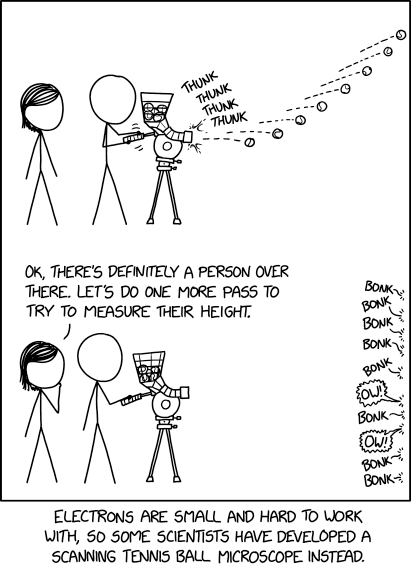Tennis Balls

After initial tests created a series of large holes in the wall of the lab, the higher-power Scanning Tunneling Tennis Ball Microscope project was quickly shut down.

After initial tests created a series of large holes in the wall of the lab, the higher-power Scanning Tunneling Tennis Ball Microscope project was quickly shut down.
A scanning electron microscope produces images of a sample by scanning the surface with a focused beam of electrons, and interpreting the different signals that are generated in response. They are used in a wide range of fields to produce high-resolution images of surfaces, enabling analysis of materials, structures, and even trace evidence. Since Megan and Cueball find electrons too small to work with, they have created a macroscopic version using tennis balls instead. The tennis ball launcher uses a similar mechanism to a scanning electron microscope: it fires tennis balls, instead of electrons, over a wide range of heights, and detects objects obstructing the stream (in this case a person) by the noises generated on impact. However, this would mostly be 'useful' in scanning things at a macroscopic level, so is not really a microscope. Computational microscopy can be used to increase the resolution of an image beyond the size of the sampling medium by extensively analyzing details of interactions, and a tennis ball microscope could potentially be used to tune such algorithms at an observable scale — the joke of striking a human, as well as the manual single-ball operation, imply that Randall did not intend this use.
Megan and Cueball have detected a person using their device, by the fact that it generated two yells during the scan, possibly from impacting the person's face and another sensitive part of their body. They intend to repeat the experiment to determine the person's height, by working out the angle of the tennis balls that generate the yells. Combined with the velocity and time to impact, this should give them enough information to work out the height above ground at impact and the distance from the launcher. The joke is that this height measurement could probably have been completed with a visual assessment, and with far more accuracy than using tennis balls to approximate their height. Most humans work with large-scale objects in their day-to-day lives and hence do not see by using a microscope, although the lens in the eye operates on the same principle as the objective lens in an optical one. This method is also likely to be problematic, as the person would likely duck or run away in response to being bombarded with tennis balls, affecting future measurements. This is known as the Observer Effect as well as a normal consideration of sampling. (It may also be why the 'scanning' is done from the top down, as early low-hitting projectiles might reduce the height that later projectiles can detect.)
The title text is a reference to scanning tunneling microscopes, which take advantage of the quantum tunnelling effect. In this case, the tennis balls were actually tunneling through the wall, creating holes in the process, which is not what tunneling electrons would do. Tunneling is a non-intuitive quantum phenomenon whereby particles may "teleport" across a barrier they would otherwise bounce off of, but it requires a number of particles of extremely low mass to exploit quantum effects, with a comparatively thin barrier, to be observable. It would not be reasonable to produce this effect at tennis ball scale with any typical building wall, but naively attempting to do so by launching tennis balls at a sufficiently high velocity (the required speed dependant upon whether they are aimed at the likes of plasterboard, brick or concrete) could lead to damaging the wall instead. "Scanning Tunneling Tennis Ball Microscope" capable of launching tennis balls at velocities, sufficient to do large holes in lab walls (presumably, concrete), could be very useful as a weapon—especially if tennis balls were swapped for stronger projectiles (e.g. tennis-ball-sized lead or steel bullets).